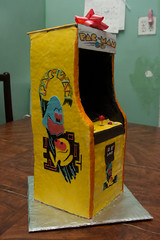During Giant Bomb’s Game of the Year deliberations, one of the panelists was talking about how the difference between Pacman and Pacman Championship Edition DX reflects the difference in video game design over the past thirty years. The original Pacman is a stress-enducing game while Pacman CE DX is an empowering experience. Pacman punishes you for the smallest mistake, only gives you four power pellets per maze, and gets more punishing the further you go. By contrast, Pacman CE DX uses a bullet-time effect to give you a chance to turn past ghosts you might otherwise have crashed into, the power pellet regenerate, and the game becomes generally more fun the faster and more frenetic it gets. The ghosts, save one or two, follow you around and aren’t much of a menace unless you come back around to your tail as in the game snake or need to exit through a hole where a sleeping ghost waits. And this wasn’t limited to Pacman, tvtropes has a whole trope dedicated to this called Nintendo hard. Why has this change come about?
Like nearly everything else in life, it mostly has to do with economics and changes in the market. I grew up with this second wave of video games launched by the Nintendo Entertainment System in the 80s. I never beat any game I had for the NES. I’ve beat nearly every game I’ve played since the Nintendo 64. What changed? Arcades lost relevance. I was a little too young to have been an arcade rat, but I do remember going to them as a kid and loving playing them. For one thing, the newest arcade machines were always better than whatever you could get on your console. (This changed with the Nintendo 64 – this is key)
Despite the limited capabilities of our console hardware in those days, the majority of the good quality games to appear on the systems were ports of arcade games. Why? Economics. There were a lot of weird games back then. How did you know which ones would be successful ahead of time? Well, if the kids loved playing the games at the arcades, they’d surely love those same games at home. Success stories included Street Fighter, Mortal Kombat, NBA Jams, and a bunch of other Midway titles. And, in general, if the games weren’t made by Nintendo themselves, the only good ones WERE the arcade ports. And the game designers and publishers didn’t have to worry about cannibalizing their arcade profits because the console versions were always sub-par due to console limitations.
How did this affect how hard games were? Again, economics. If you design arcade games you have one simple goal – get as many quarters as you can from your customers. This allows the owner of the arcade cabinet to recoup the cost of the hardware. So you needed your game to be as hard as possible so that the user would have to keep adding quarters. Additionally, you didn’t want one player monopolizing the machine. You wanted the best to be good enough to impress others and get them to try and best him (hence the introduction of scores and high score tables), but not bore them by lasting forever. Of course, when the programmers were porting these games to the Nintendo and Sega systems, they weren’t going to waste money changing the games to reflect the fact that console users didn’t have to input quarters. They were just going to do just enough code to get the code to compile for this new system.
Then something happened in the mid-1990s. The Nintendo 64 came out. That year the only difference between the arcade version and the home console version of Cruisin’ USAis that you didn’t sit in a chair with pedals and a wheel. (And those accessories could be bought for a price) I’m not saying the Nintendo 64 single-handedly killed the arcade. I haven’t done enough research to know if there were other more powerful factors. But it certainly made a difference. Except maybe once, I never put any money into a Cruisin’ USA arcade machine. I could essentially get the same experience all weekend long by spending $4 at Blockbuster. And with the Playstation launching soon after that with a CD-ROM to hold up to 650 MB of data, there almost wasn’t a reason to play a game at the arcade. The port would no longer be a poor imitation. It would essentially be the same thing.
Of course, it took video game designers a little while to catch up, but you started to see cracks in the armor around that time. None of Nintendo’s first party games had really been hard since the SNES. In the N64 era they just got even easier. They also mostly got rid of timers and scores. Prince of Persia: Sands of Time, released about half a decade later, didn’t even bother with punishing you for death. Whenever you died, you were told that it was a story-telling error and you backed up (using the sand of time) to before you died.
Freed of the need to punish the user, video game designers began working in the opposite direction – empowering users. Games became about an escape from life. Before they were no different than playing a game of tic tac toe; they gave stress release but you were still playing a game. But now you became a Marine or Space Marine or medieval Assassin. And if you’re a member of an elite squad of some elite special forces, it doesn’t make sense for things to be hard for you and for you to always be dying. It makes sense for the situation to challenge you, but not to dominate you. (And you often hear criticisms nowadays when this is the case)
In fact, the pendulum has swung so far in the opposite direction that some games have begun to challenge our ability to suspend our disbelief. A great example is the Uncharted series. In Uncharted, the only thing fatal to Nathan Drake is a long fall. Any other wounds are healed through time. And not in the Final Fantasy sense of staying at an Inn overnight. Just find a place with good cover and you can survive being shot with an uzi. The first Assassin’s Creed game was similar. The next two have been *slightly* more realistic with the hero needing to take medicine.
And so we end up with this extremely satisfying new Pacman. They don’t need to get your quarters anymore. They just want you to enjoy eating dots and ghosts. And, while I think Pacman CE DX can be enjoyed by anyone, those of us who grew up on original Pacman get the extra cathartic vengeance on those ghosts who were so unbeatable before.


6 responses to “80s Games vs Today’s Games”
The transition out of the arcade taught everyone that when the player won, the game didn’t lose. When you don’t need to take quarters you don’t have to make a game hard for the sake of being hard.
Shifting the focus away from survival toward maximizing score in a time limit is the best thing that could have been done to Pac-Man. Players focus on what was pure and great about the game instead of worrying about credits and money.
PS: Nathan Drake survives uzi shots because word of god says that he’s never hit by any bullets until the killing blow. You’re just being told about the danger inherent in the situation as the color washes out.
I thought about mentioning that little tidbit about Uncharted. It’s still a bit of a mood-ruining hack to think that none of the bullets hit him but the last one.
That may be true, but let me ask you this question:
Until which turn does the dog stop chasing its tail?
The last one!
As they say in the science community:
Q.E.D., bitches
[…] spot, you could be left in an unwinnable state. It was a really weird and cruel stance to take. As I mentioned last week, games in the 80s had a reason to make you die – because they were often based on arcade […]